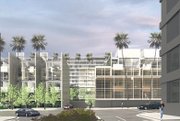Residential Developers Eying More Retail Properties
The hot housing market, which lately has been trickling into metropolitan areas, has led residential developers on an all-out search for available land, but with little available, they are starting to tread on the once-sacred area of retail real estate.
A number of former retail sites across the region are being converted into condominiums, lofts and other types of housing, and that may put further pressure on retail space rates.
Until recently, developers have mainly been targeting troubled office space, parking lots and old industrial buildings to convert into lofts and condominiums, but with demand still strong despite an uptick in mortgage rates, retail space is no longer considered sacred.
“You literally have run out of land in the urban core, so now any time any type of property comes on the market, everyone is going to look at it,” said Jack Kyser, senior economist for the Los Angeles County Economic Development Corporation.
The addition of residential developers into the mix may put more pressure on retail landlords.
Recent activity has been fueled by the continued consolidation on the departmentstore front. Federated Department Stores’ acquisition of Robinsons-May left dozens of empty stores in its wake, as did Sears’ acquisition of Kmart.
Real-estate investors like Beverly Hills–based New Pacific Realty have taken advantage. The developer acquired the very visible Robinsons-May store in Beverly Hills, but rather than convert it to a Bloomingdale’s or Saks, it will build a 252-unit ecofriendly condo complex.
In Orange County, the one-time hot spot Triangle Square in Costa Mesa is also targeted for housing. Another troubled shopping center, the Beverly Connection in Los Angeles, is being converted from retail to mixed-use, adding 62 luxury condominiums and a 177-unit assisted-living facility for senior citizens. Several of the former Kmart sites are also slated for housing.
In more instances, residential uses are more profitable than a struggling shopping center. In some cases, both uses can work on the same site.
Shaheen Sadeghi, developer of The Lab anti-mall and its outdoor-oriented counterpart The Camp, is also getting in on the action with a plan to build 70 to 100 sustainable lofts behind The Camp in Orange County’s SoBeCa district.
“It will have the same DNA, but applicable to a residential concept,” said Sadeghi, referring to those centers’ socially friendly environments.
“What’s happened is that everything we do involves culture,” Sadeghi continued. “A lot of our customers have been coming here for nine and 10 years. They go to the vegan restaurants, learn scuba and involve themselves socially. The lofts will be an extension of that.”
Despite slowing housing sales in the suburbs, developers are betting that interest will remain strong in urban markets.
“We had eight sales last week. A lot of people are saying the market is soft, but there’s still a shortage of housing,” said Mark J. Weinstein, principal of Santa Monica, Calif.–based real estate firm MJW Investments, which built the L.A. Fashion District’s first loft development at Santee Village. The multi-line housing development is down to its last 10 units for its Textile Building condos but will be adding 216 units nearby next summer.
Santee Village was built using former manufacturing facilities. Seeing developers take over retail properties for housing is unusual, Weinstein said, but regardless of building type, he thinks the key to residential development still comes down to cost issues rather than land use.
“You still have to figure out how much you can get for the land and how it can work out,” he explained.
Kyser added that in many cases it comes down to what the city wants to do, and city officials usually do not like to see empty shopping centers and lost tax dollars.
Triangle Square was a thriving redevelopment concept in the 1990s. Nike Inc. chose the site for one of its first Niketown stores. Virgin MegaStore also moved in, along with clothing stores like The Closet. Now it sits half full and reaps only one-fifth of expected tax revenues for the city of Costa Mesa.
“Triangle Square never really worked well as a retail concept,” said Sadeghi. “Adding housing seems to be a viable alternative, but it will also depend on how the new owners execute.”
The Beverly Connection was also struggling with vacancy issues. Owner Vornado Realty Trust hopes the newly renovated center with housing will lure more retail tenants. Both the condos and the assisted living center will be built above ground-level retail.
More lofts for Fashion District workers
Kor Development, which developed the Eastern Columbia Lofts on Broadway in downtown Los Angeles, unveiled a new project—the Barker Block, located in the Arts District, just east of the L.A. Fashion District.
The project will bring 297 live/work lofts to the market. All units will be offered as for-sale condominiums, with prices to be determined. The units will range from 734 to about 3,000 square feet, featuring brick walls, timber rafters, wood and concrete flooring, skylights, mezzanines, basements and ground-floor patios. Occupancy will begin in three phases starting in the third quarter of 2007.
The development is located at 510 Hewitt St., which used to be a manufacturing district and home to the Barker Bros. furniture company, which owned a number of buildings in the area that date back to the 19th century.
The Barker Block project will be built using seven of the interconnected buildings. The noted Los Angeles architecture firm Nakada & Associates is designing the project.
The Barker Block is adjacent to the work-in-progress Biscuit Company Lofts and the finished Toy Factory Lofts by Linear City Development. Kor has also developed the Molino Street Lofts in the same area. The area has already become home to several apparel companies including Adriano Goldschmied. An Oct. 26 reception was attended by several designers looking for new homes. For more information, visit www.barkerblock.com.






















